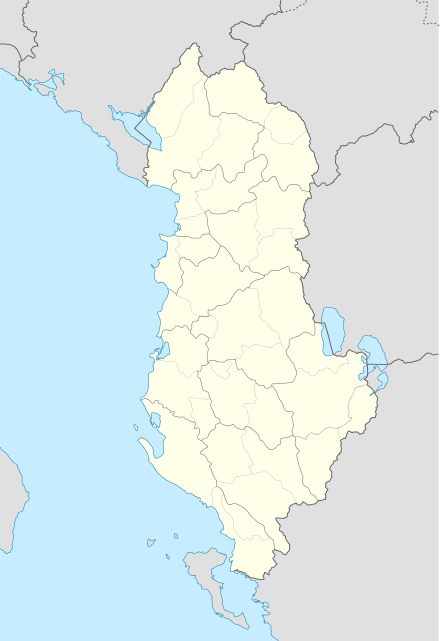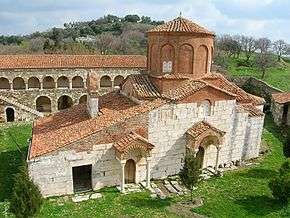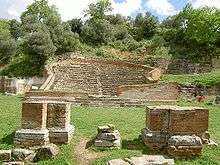Apollonia (Illyria)
|
Monument of Agonothetes | |
 Shown within Albania | |
| Location | Fier County, Albania |
|---|---|
| Region | Illyria |
| Coordinates | 40°43′18.44″N 19°28′23.04″E / 40.7217889°N 19.4730667°ECoordinates: 40°43′18.44″N 19°28′23.04″E / 40.7217889°N 19.4730667°E |
Apollonia (Albanian: Apolonia; Greek: Ἀπολλωνία κατ᾿ Ἐπίδαμνον or Ἀπολλωνία πρὸς Ἐπίδαμνον, Apollonia kat' Epidamnon or Apollonia pros Epidamnon) was an ancient Greek city[1] located on the right bank of the Aous river (modern-day Vjosë). Its ruins are situated in the Fier region, near the village of Pojani (Polina), in modern-day Albania. Apollonia was founded in 588 BCE by Greek colonists from Corfu and Corinth,[2] on a site where native Illyrian tribes[3] lived, and was perhaps the most important of the several classical towns known as Apollonia. Apollonia flourished in the Roman period and was home to a renowned school of philosophy, but began to decline in the 3rd century AD when its harbor started silting up as a result of an earthquake. It was abandoned by the end of Late Antiquity.
The name of the city is mentioned among the modern bishoprics of the Orthodox Autocephalous Church of Albania (Apollonia and Fier). Apollonia is also a titular see of the Latin Church.
History
.svg.png)
The site of Apollonia lay on the territory of the Taulantii, a cluster of Illyrian tribes that remained closely involved with the settlement for centuries and lived alongside the Greek colonists.[4] The city was said to have originally been named Gylakeia after its founder, Gylax,[5] but the name was later changed to honor the god Apollo. Although this wasn't the only city named by the god Apollo. There were 24 other cities named Apollo, but Illyria's Apollo was the most important and played a major role as a trading intermediary between the Hellenists and the Illyrians. It is estimated that the city had about 60,000 inhabitants. In the first period of existence, Apollonia was not just a shopping mall in Corinth and Corky in Illyria. The geographical position of Apollonia also gave rise to the development of agriculture, also the population grew and soon became a rich city. According to Strabo, the Apollo population increased with the arrival of expatriates from the Hellenic cities of Kikys and Dyspont who chose Dyrrah and Apolonia themselves to settle.
It is mentioned by Strabo in his Geographica as "an exceedingly well-governed city".[6] Aristotle considered Apollonia an important[5] example of an oligarchic system, as the descendants of the Greek colonists controlled the city and helped Illyrians to learn how to govern. The city grew rich on the slave trade and local agriculture, as well as its large harbour, said to have been able to hold a hundred ships at a time. The city also benefited from the local supply of asphalt[7][8] which was a valuable commodity in ancient times, for example for caulking ships. The remains of a late sixth-century temple, located just outside the city, were reported in 2006; it is only the fifth known stone temple found in present-day Albania.[9] Some archeological objects found in Apollonia (however scarce) are a good indication that the local population played a role in the social and political life of Apollonia. The rise of the colonies has been conditioned by the interests of the two sides, the ruling class Corinth-Korkyra, on the one hand, and the Illyrian tribal aristocracy on the other. Placing regular exchanges with the Hellenis was also profitable for the tribal aristocracy of the country, because in that way it could exchange colonists with over-payments accumulated by it.
Apollonia, like Dyrrachium further north, was an important port on the Illyrian coast as the most convenient link between Brundusium and northern Greece, and as one of the western starting points of the Via Egnatia leading east to Thessaloniki and Byzantium in Thrace.[10] It had its own mint, stamping coins showing a cow suckling her calf on the obverse and a double stellate pattern on the reverse,[11] which have been found as far away as the basin of the Danube.
The city was for a time included among the dominions of Pyrrhus of Epirus. In 229 BC, it came under the control of the Roman Republic, to which it was firmly loyal; it was rewarded in 168 BC with booty seized from Gentius, the defeated king of Illyria. In 148 BC, Apollonia became part of the Roman province of Macedonia, specifically of Epirus Nova.[12] In the Roman Civil War between Pompey and Julius Caesar, it supported the latter, but fell to Marcus Iunius Brutus in 48 BC. The later Roman emperor Augustus studied in Apollonia in 44 BC under the tutelage of Athenodorus of Tarsus; it was there that he received news of Caesar's murder.
Apollonia flourished under Roman rule and was noted by Cicero in his Philippicae as magna urbs et gravis, a great and important city. Christianity was established in the city at an early stage, and bishops from Apollonia were present during the First Council of Ephesus (431) and the Council of Chalcedon (451). Its decline, however, began in the 3rd century AD, when an earthquake changed the path of the Aoös, causing the harbour to silt up and the inland area to become a malaria-ridden swamp. The city became increasingly uninhabitable as the inland swamp expanded, and the nearby settlement of Avlona (modern-day Vlorë) became dominant. By the end of antiquity, the city was largely depopulated, hosting only a small Christian community. This community (which probably is part of the site of the old city) built on a nearby hill the church of the Dormition of the Theotokos, (Albanian: Shën Mëri), part of the Ardenica Monastery.
Social order and political organization
If we refer to an Aristotle news that gives us in his "Politica" writing that "We have a democracy when the free, though few, rule over the majority of the free population as happened in Apollonia, which is in the Ionian Sea . From this it is a definite fact that in Apollonia ruled the slave sovereign rule in its most classical way. In Apollonia a good part of slaves were owned by the slave-sovereign state, used mainly for social constructions or jobs that were called shame to work by the free. Besides state slaves there were also private slaves who worked in metalworking, agriculture, or even as housekeepers. While in the free population group belonged to nobility who even established the colony first. The other free-form was made up of the owners of workshops, traders and craftsmen. In addition to this mass and slave there was another social scale which consisted of foreign people without the right of citizenship. The Apolloniate Society was divided according to several criteria: free and slaves, rich and poor, aristocrats, demos and aliens (outsiders/strangers). Apollos had a tougher policy on foreigners in the city. Elian writes that "the Apollonians expelled the aliens according to the law of the Lakeview". According to archaeologist N. Ceka, this eviction was due to the colony's agrarian character and was jealous of its lands and was trying to expand at the expense of its neighbors.
The rapid economic development and craftsmanship of the city as well as the exchange of goods that had settlers with the Illyrian population came to the strengthening of the crafts and commercial layers. This layer came up against the oligarchic group in order to gain power and use it in the service of their interests. As a result, in Dyrrah in 437 p.e.s. exploded in a demo uprising, which later brought the Peloponnesian War. The Illyrians who supported the expelled aristocracy from the city also participated in the war, so they were ranked in the group that supported Athens in the war against the Peloponnese League. As a result of the Civil War in Dyrrachium, we have the full triumph of the principle of class division of society and the strengthening of the skeleton pole. Power now passes by the hands of the narrow circle of aristocracy into the hands of all the slaves. On this occasion, the position of the Illyrians living in the city strengthened. Such a phenomenon also happened in Apollonia. These changes were also made by state functions. The Phylark's place (aristocratic rulers) was now occupied by a collegian body, a bureau (council), members who could be not only nobles but also other slave-slavers. Helie was also created (body of the general people's meeting) which was tasked with adopting laws, making important decisions and selecting and controlling the activities of the executive organs of the city.
By the members of Byles, at the beginning of each year, was elected to asky, who was the highest civilian official of the city, whose names were all the laws, decrees and decisions promulgated during the year. Another body was the toxark (commander of the archers) and dealing with the military issue and the war. The secretary made stoning in rocks or copper plates of laws, decrees, and decisions taken by helias or senior executive bodies and made them public. The three hierarchs took part in organizing the cult, organizing games and parties, and apparently also with the city's financial affair. In addition, there were other lower ranking officers who played an important role in economic life, such as the employee in charge of coinage which, besides having to secure the raw material, also had to distribute of coins. Another official was the pole who had to deal with the Illyrians' trade regulation according to Plutarch, "this was elected every year among the most popular citizens to go to the barbarians on behalf of all citizens."
Discovery and excavation results
The city seems to have sunk with the rise of Vlora.[10] It was "rediscovered" by European classicists in the 18th century, though it was not until the Austrian occupation of 1916–1918 that the site was investigated by archaeologists. Their work was continued by a French team between 1924–1938. Parts of the site were damaged during the Second World War. After the war, an Albanian team undertook further work from 1948 onwards, although much of the site remains unexcavated to this day. Some of the team's archeological discoveries are on display within the monastery, known as the Museum of Apollonia (opened in 1958) and other artifacts from Apollonia are in the capital Tirana. Unfortunately, during the anarchy that followed the collapse of the communist party in 1990 and reversion to capitalism, the archeological collection was plundered and the museum was temporarily closed. The ruins were also frequently dug up by plunderers for relics to be sold to collectors abroad. In December 2011, a new museum opened, under the directorship of Marin Haxhimihali.[13] It replaced an older museum dating from 1985, and was funded by UNESCO's MDG-F Joint Programme ”Culture and Heritage for Social and Economic Development”.
In August 2010, a French-Albanian team of archaeologists unearthed a bust of a Roman soldier, 50 years after the discoveries of other full body statues in the 1958-1960 period expeditions, led by Albanian scholar Selim Islami and Russian Professor Blavatski.[14]
A German-Albanian team has been working on the Hellenistic theatre at Albania, throwing light on the development of Greek theatres and also local variants[15]
Episcopal history

A bishopric was founded there circa 400 AD but usspressed around 599. One of the participants in the Council of Ephesus in 431 was a Felix who signed once as Bishop of Apollonia and Byllis, at another time as Bishop of Apollonia. Some assume that the two towns formed a single episcopal see, others suppose he was, strictly speaking, Bishop only of Apollonia, but was temporarily in charge also of Byllis during a vacancy of that see (apostolic administrator). One of the participants at a council held in Constantinople in 448 signed as Paulus Episcopus Apolloniada al. Apolloniatarum, civitatis sanctae ecclesiae, but it is uncertain whether he was associated with this Apollonia. At the Council of Chalcedon in 451, Eusebius subscribed simply as Bishop of Apollonia. In the letter of the bishops of Epirus Nova to the Byzantine Emperor Leo I in 458, Philocharis subscribes as Bishop of what the manuscripts call "Vallidus", and which editors think should be corrected to "Byllis". Whether Philocharis is to be considered Bishop also of Apollonia depends on the interpretation of the position of Felix in 431.[16][17][18]
Latin titular see

The Annuario Pontificio lists Apollonia as a titular see, thus recognizing that it was once a residential diocese, a suffragan of the archbishopric of Dyrrachium,[19] It grants no such recognition to Byllis.[20] Metropolitan of the Roman province of Epirus Novus.
Notable locals
- Isocrates of Apollonia (born before 368 BC) Greek rhetorician and pupil of the elder Isocrates
See also
References
Citations
- ↑ Wilkes 1995, p. 96; Wilson 2006, p. 594; Chamoux 2003, p. 97.
- ↑ Wilkes 1995, pp. 96–98.
- ↑ Hammond 1976, p. 426; Larson 2001, p. 162.
- ↑ Wilkes 1995, p. 98.
- 1 2 Hansen & Nielsen 2004, p. 328.
- ↑ Strabo. Geographica, 7.8.316.
- ↑ Strabo. Geographica. pp. VII.5.8.
- ↑ Aristotle. De mirabilibus auscultationibus. pp. 842 b.27.
- ↑ University of Cincinnati (6 January 2006). "Researchers Discover Greek Temple In Albania Dating Back To 6th Century B.C." Science Daily. Retrieved 16 July 2008.
- 1 2

- ↑ Illyria, Apollonia - Ancient Greek Coins - WildWinds.com
- ↑ Bowden 2003, p. 14.
- ↑ UNESCO Office in Venice: Apollonia Archaeological Museum reopens after 20 years of closure
- ↑ Murati, Violeta (15 August 2010). "In Apollonia the bust of a Roman athlete is unearthed". Standard (in Albanian). Archived from the original on 17 August 2010. Retrieved 19 August 2010.
- ↑ "DAI Research Projects Apollonia". Archived from the original on 2011-08-05.
- ↑ Daniele Farlati-Jacopo Coleti, Illyricum Sacrum, vol. VII, Venezia 1817, pp. 395-396
- ↑ Michel Lequien, Oriens christianus in quatuor Patriarchatus digestus, Parigi 1740, Vol. II, coll. 248-249
- ↑ Louis Petit, "Byllis" in Catholic Encyclopedia (New York 1908)
- ↑ Annuario Pontificio 2013 (Libreria Editrice Vaticana 2013 ISBN 978-88-209-9070-1), p. 835
- ↑ Annuario Pontificio 2013 (Libreria Editrice Vaticana 2013 ISBN 978-88-209-9070-1), "Sedi titolari", pp. 819-1013
External links
- Bowden, William (2003). Epirus Vetus: The Archaeology of a Late Antique Province. London, United Kingdom: Duckworth. ISBN 0-7156-3116-0.
- Chamoux, François (2003). Hellenistic Civilization. Oxford, United Kingdom: Blackwell Publishing. ISBN 0-631-22242-1.
- Hammond, Nicholas Geoffrey Lemprière (1976). Migrations and Invasions in Greece and Adjacent Areas. Park Ridge, New Jersey: Noyes Press. ISBN 0-8155-5047-2.
- Hansen, Mogens Herman; Nielsen, Thomas Heine (2004). An Inventory of Archaic and Classical Poleis. Oxford, United Kingdom: Oxford University Press. ISBN 0-19-814099-1.
- Larson, Jennifer Lynn (2001). Greek Nymphs: Myth, Cult, Lore. Oxford, United Kingdom: Oxford University Press. ISBN 0-19-514465-1.
- Wilkes, John (1995). The Illyrians. Oxford, United Kingdom: Blackwell Publishing. ISBN 0-631-19807-5.
- Wilson, Nigel Guy (2006). Encyclopedia of Ancient Greece. New York, New York and Oxford, United Kingdom: Routledge (Taylor & Francis). ISBN 978-0-415-87396-3.